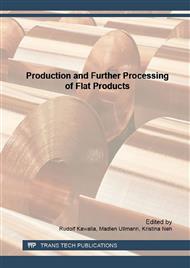p.3
p.9
p.16
p.22
p.29
p.35
p.42
p.51
On the Correlation between Microstructure Homogeneity and Formability in Two Multi Phase Steels Treated with Different Cooling Strategies
Abstract:
In the scope of the optimization of multi phase steels, e.g. for the automotive industry, control of the microstructure is essential to tailor the mechanical properties. In this study, two cold rolled steels varying in carbon content were annealed and cooled under different laboratory conditions. The microstructure is investigated using optical and electron microscopy and EBSD. The results are correlated to the mechanical properties obtained from tensile, hole expansion and bending test. It is found that tensile strength and elongation are mainly dependent on martensite volume fraction, while yield strength is less affected by chemical composition or annealing treatment. In contrast, hole expansion capacity and maximum bending angle are significantly improved by the homogenization of the microstructure which is independent of strength and elongation. The microstructure homogeneity is expressed by analyzing the Lorenz curves derived from the kernel average misorientation from EBSD measurements.
Info:
Periodical:
Pages:
22-28
Citation:
Online since:
May 2016
Authors:
Keywords:
Permissions:
Share:
Citation:


